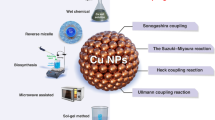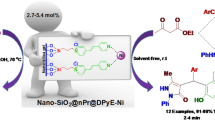Abstract
The Pd nanoparticles generated in situ from Pd–pincer complexes catalyzed Heck coupling reaction. For this purpose, new Pd(II)–ONO pincer complexes (1–4) containing acylthiourea ancillary ligand were obtained by treating [Pd(ONO)(CH3CN)] with the respective N-substituted carbamothioyl benzamide ligand (L1–L4). Formation of these complexes was confirmed by UV–Visible, FT-IR, NMR and mass spectroscopic techniques. The sizes of in situ formed Pd nanoparticles were greatly affected by the substituent in ancillary ligand, which in turn influenced their catalytic activity towards Heck coupling reaction. The in situ formed Pd nanoparticles during Heck reaction were removed from the reaction medium and analyzed using HR-TEM to estimate the sizes of the Pd nanoparticles. Complex [Pd(ONO)((N-benzylcarbamothioyl)benzamide)] (1) which does not possess any substituent on the benzyl moiety of acylthiourea produced the smallest Pd nanoparticles with the average particle size of 3.7 nm. Hence, complex 1 showed the utmost catalytic activity. With complex 1, 51–99% of conversion was observed during Heck coupling reaction of styrene with various aryl halides. XPS results confirmed that the recovered black particles were Pd(0). A reasonable recyclability results were achieved by these in situ generated Pd nanoparticles.
Graphic Abstract










Similar content being viewed by others
References
Garagorri DB, Kirchner K (2008) Modularly designed transition metal PNP and PCP pincer complexes based on aminophosphines: synthesis and catalytic applications. Acc Chem Res 41:201–213
Morales DM, Jensen CM (2007) The chemistry of pincer compounds. Elsevier, Amsterdam
Peris E, Crabtree RH (2018) Key factors in pincer ligand design. Chem Soc Rev 47:1959–1968
Lee DW, Jensen CM, Morales DM (2003) Reactivity of iridium PCP pincer complexes toward CO and CO2. Crystal structures of IrH(κ2-O2COH){C6H3-2,6-(CH2PBut2)2} and IrH(C(O)OH){C6H3-2,6-(CH2PBut2)2}H2O. Organometallics 22:4744–4749
Van Koten G (1989) Tuning the reactivity of metals held in a rigid ligand environment. Pure Appl Chem 61:1681–1694
Albrecht M, van-Koten G (2001) Platinum group organometallics based on “pincer” complexes: Sensors, switches, and catalysts. Angew Chem Int Ed 40:3750–3781
Johansson-Seechurn CCC, Kitching MO, Colacot TJ, Snieckus V (2012) Palladium-catalyzed cross-coupling: a historical contextual perspective to the 2010 Nobel prize. Angew Chem Int Ed 51:5062–5085
Van-der-Boom ME, Milstein D (2003) Cyclometalated phosphine-based pincer complexes: mechanistic insight in catalysis, coordination, and bond activation. Chem Rev 103:1759–1792
Hazari N, Melvin PR, Beromi MM (2017) Well-defined nickel and palladium precatalysts for cross-coupling. Nat Rev Chem 1:1
Selander N, Szabo K (2011) Catalysis by palladium pincer complexes. Chem Rev 111:2048–2076
Jang M, Cai L, Udeani GO, Slowing KV, Thomas CF, Beecher CW, Fong HH, Farnsworth NR, Kinghorn AD, Mehta RG, Moon RC, Pezzuto JM (1997) Cancer chemopreventive activity of resveratrol, a natural product derived from grapes. Science 275:218–220
Nakamura I, Yamamoto Y (2004) Transition metal-catalyzed reactions in heterocyclic synthesis. Chem Rev 104:2127–2198
Czajkowska-Szczykowska D, Morzycki JW, Wojtkielewicz A (2015) Pd-catalyzed steroid reactions. Steroids 97:13–44
Lin KH, Hsiao G, Shih CM, Chou DS, Sheu JR (2009) Mechanisms of resveratrol-induced platelet apoptosis. Cardiovasc Res 83:575–585
Wang Z, Huang Y, Zou J, Cao K, Xu Y, Wu JM (2002) Effects of red wine and wine polyphenol resveratrol on platelet aggregation in vivo and in vitro. Int J Mol Med 9:77
Brito PM, Devillard R, Salvayre AN, Almeida LM, Dinis TC, Salvayre R, Auge N (2009) Resveratrol inhibits the mTOR mitogenic signaling evoked by oxidized LDL in smooth muscle cells. Atherosclerosis 205:126–134
Zou J, Huang Y, Chen Q, Wang N, Cao K, Hsieh TC, Wu JM (1999) Suppression of mitogenesis and regulation of cell cycle traverse by resveratrol in cultured smooth muscle cells. Int J Oncol 15:647
Heck RF, Nolley JP (1972) Palladium-catalyzed vinylic hydrogen substitution reactions with aryl, benzyl and styryl halides. J Org Chem 37:2320–2322
González-Sebastián L, Morales-Morales D (2019) Cross-coupling reactions catalysed by palladium pincer complexes. A review of recent advances. J Organomet Chem 893:39–51
Arghan M, Koukabi N, Kolvari E (2018) Mizoroki-Heck and Suzuki-Miyaura reactions mediated by poly(2-acrylamido-2-methyl-1-propanesulfonic acid)-stabilized magnetically separable palladium catalyst. Appl Organomet Chem 32:e4346
Zhu K, Dunne J, Shaver MP, Thomas SP (2017) Iron-catalyzed Heck-type alkenylation of functionalized alkyl bromides. ACS Catal 7:2353–2356
Makoa TL, Byers JA (2016) Recent advances in iron-catalysed cross coupling reactions and their mechanistic underpinning. Inorg Chem Front 3:766–790
Kwiatkowski MR, Alexanian EJ (2018) Nickel-catalyzed Mizoroki–Heck-type reactions of unactivated alkyl bromides. Angew Chem Int Ed 57:16857–16860
Sharma KN, Satrawala N, Srivastava AK, Ali M, Joshi RK (2019) Palladium(II) ligated with a selenated (Se, CNHC, N−)-type pincer ligand: an efficient catalyst for Mizoroki-Heck and Suzuki-Miyaura coupling in water. Org Biomol Chem 17:8969–8976
Das D, Rao GK, Singh AK (2009) Palladium(II) complexes of the first pincer (Se, N, Se) ligand, 2,6-Bis((phenylseleno)methyl)pyridine (L): solvent-dependent formation of [PdCl(L)]Cl and Na[PdCl(L)][PdCl4] and high catalytic activity for the Heck reaction. Organometallics 28(20):6054–6058
Babu SG, Neelakandeswari N, Dharmaraj N, Jackson SD, Karvembu R (2013) Copper(II) oxide on aluminosilicate mediated Heck coupling of styrene with aryl halides in water. RSC Adv 3:7774–7781
Mohan A, Rout L, Thomas AM, Peter J, Nagappan S, Parambadath S, Ha CS (2020) Palladium nanoparticles-anchored dual-responsive SBA-15-PNIPAM/PMAA nanoreactor: a novel heterogeneous catalyst for a green Suzuki-Miyaura cross-coupling reaction. RSC Adv 10:28193–28204
Mayakrishnan G, Karvembu R, Kim IS (2014) Highly active, selective, and reusable RuO2/SWCNT catalyst for Heck olefination of aryl halides. ACS Catal 4(7):2118–2129
Gunanathan C, Milstein D (2014) Bond activation and catalysis by ruthenium pincer complexes. Chem Rev 114:12024–12087
Jung IG, Son SU, Park KH, Chung KC, Lee JW, Chung YK (2003) Synthesis of novel Pd−NCN pincer complexes having additional nitrogen coordination sites and their application as catalysts for the Heck reaction. Organometallics 22:4715–4720
Berkessel A, Cleemann F, Mukherjee S, Müller TN, Lex J (2005) Highly efficient dynamic kinetic resolution of azlactones by urea-based bifunctional organocatalysts. Angew Chem Int Ed 44:807–811
Chua CK, Ambrosi A, Pumera M (2012) Graphene oxide reduction by standard industrial reducing agent: thiourea dioxide. J Mater Chem 22:11054–11061
Sheeba MM, Preethi S, Nijamudheen A, Tamizh MM, Datta A, Farrugia LJ, Karvembu R (2015) Half-sandwich Ru(η6-C6H6) complexes with chiral aroylthioureas for enhanced asymmetric transfer hydrogenation of ketones – experimental and theoretical studies. Catal Sci Technol 5:4790–4799
Jeyalakshmi K, Haribabu J, Bhuvanesh NSP, Karvembu R (2016) Half-sandwich RuCl2(η6-p-cymene) core complexes containing sulfur donor aroylthiourea ligands: DNA and protein binding, DNA cleavage and cytotoxic studies. Dalton Trans 45:12518–12531
Satheesh K, Jayavel R (2013) Synthesis and electrochemical properties of reduced graphene oxide via chemical reduction using thiourea as a reducing agent. Mater Lett 113:5–8
Selvakumaran N, Bhuvanesh NSP, Karvembu R (2014) Self-assembled Cu(II) and Ni(II) metallamacrocycles formed from 3,3,3′,3′-tetrabenzyl-1,1′-aroylbis(thiourea) ligands: DNA and protein binding studies, and cytotoxicity of trinuclear complexes. Dalton Trans 43:16395–16410
Serdyuk OV, Heckel CM, Tsogoeva SB (2013) Bifunctional primary amine-thioureas in asymmetric organocatalysis. Org Biomol Chem 11:7051–7071
Gunasekaran N, Ramesh P, Ponnuswamy MNG, Karvembu R (2011) Monodentate coordination of N-[di(phenyl/ethyl)carbamothioyl]benzamide ligands: synthesis, crystal structure and catalytic oxidation property of Cu(I) complexes. Dalton Trans 40:12519–12526
Gunasekaran N, Jerome P, Ng SW, Tiekink ERT, Karvembu R (2012) Tris-chelate complexes of cobalt(III) with N-[di(alkyl/aryl)carbamothioyl]benzamide derivatives: synthesis, crystallography and catalytic activity in TBHP oxidation of alcohols. J Mol Catal A 353:156–162
Espinet P, Miguel JA, García-Granda S, Miguel D (1996) Palladium complexes with the tridentate dianionic ligand pyridine-2,6-dicarboxylate, dipic. Crystal structure of [Pd(dipic)(PBu3)]2. Inorg Chem 35:2287–2291
Espinet P, Lorenzo C, Miguel JA, Bois C, Jeannin Y (1994) Palladium complexes with the tridentate dianionic ligand pyridine-2,6-bis(thiocarboxylate), pdtc. Crystal structure of (n-Bu4N)[Pd(pdtc)Br]. Inorg Chem 33:2052–2055
Selvakumaran N, Ng SW, Tiekink ERT, Karvembu R (2011) Versatile coordination behavior of N, N-di(alkyl/aryl)-N′-benzoylthiourea ligands: synthesis, crystal structure and cytotoxicity of palladium(II) complexes. Inorg Chim Acta 376:278–284
Priyarega S, Raja DS, Babu SG, Karvembu R, Hashimoto T, Endo A, Natarajan K (2012) Novel binuclear palladium(II) complexes of 2-oxoquinoline-3-carbaldehyde Schiff bases: synthesis, structure and catalytic applications. Polyhedron 34:143–148
Sheeba MM, Tamizh MM, Farrugia LJ, Endo A, Karvembu R (2014) Chiral (η6-p-cymene) ruthenium(II) complexes containing monodentate acylthiourea ligands for efficient asymmetric transfer hydrogenation of ketones. Organometallics 33:540–550
Jerome P, Sathishkumar PN, Bhuvanesh NSP, Karvembu R (2017) Towards phosphine-free Pd(II) pincer complexes for catalyzing Suzuki-Miyaura cross-coupling reaction in aqueous medium. J Organomet Chem 845:115–124
Jerome P, Kausalya G, Thangadurai TD, Karvembu R (2016) Green synthesis of CuO nanoflakes from copper pincer complex for effective N-arylation of benzimidazole. Catal Commun 75:50–54
Jerome P, Bhuvanesh NSP, Karvembu R (2016) Synthesis and crystal structure of a trinuclear nickel(II) ONO pincer complex [Ni(pydc)2]2[Ni(H2O)5]⋅2H2O⋅2(C6H15N). J Struct Chem 57:528–533
Jerome P, Arafath SY, Haribabu J, Bhuvanesh NSP, Karvembu R (2019) Effect of 2-bromopyridine ancillary ligand in the catalysis of Pd(II)-NNN pincer complexes towards Suzuki-Miyaura cross-coupling reaction. Chem Select 4:2237–2241
Calo V, Nacci A, Monopoli A, Fornaro A, Sabbatini L, Cioffi N, Ditaranto N (2004) Heck reaction catalyzed by nanosized palladium on chitosan in ionic liquids. Organometallics 23:5154–5158
Babu SG, Balakumar E, Jerome P, Karvembu R (2017) Pd/AlO(OH): A heterogeneous, stable and recyclable catalyst for N-arylation of aniline under ligand-free aerobic condition. Catal Lett 147:2619–2629
Acknowledgements
We are thankful to DST-SERB for the financial support (Project No. SR/S1/IC-72/2010).
Author information
Authors and Affiliations
Corresponding author
Ethics declarations
Conflict of interest
There is no conflict of interest for each contributing author.
Additional information
Publisher's Note
Springer Nature remains neutral with regard to jurisdictional claims in published maps and institutional affiliations.
Electronic supplementary material
Below is the link to the electronic supplementary material.
Rights and permissions
About this article
Cite this article
Jerome, P., Babu, S.G. & Karvembu, R. Structural Effect of Pincer Pd(II)–ONO Complexes Modified with Acylthiourea on Sizes of the In Situ Generated Pd Nanoparticles During Heck Coupling Reaction. Catal Lett 151, 1633–1645 (2021). https://doi.org/10.1007/s10562-020-03413-7
Received:
Accepted:
Published:
Issue Date:
DOI: https://doi.org/10.1007/s10562-020-03413-7




